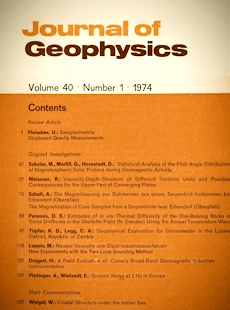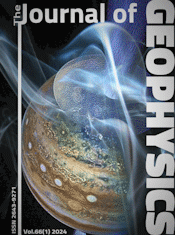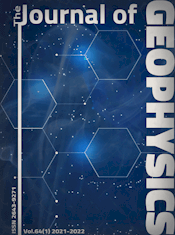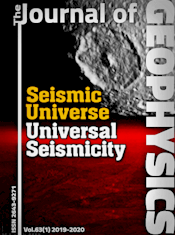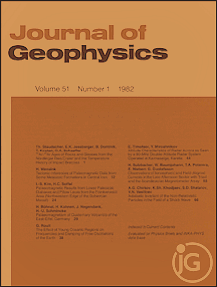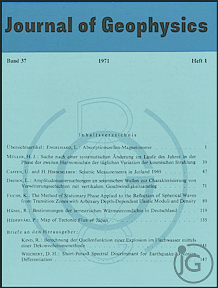Thermal enhancement of magnetic susceptibility
Article Sidebar
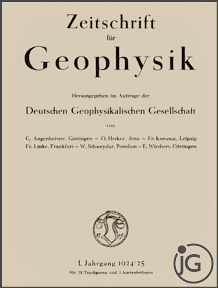
Vols. 1-18 (1924-1944), ISSN 0044-2801
Main Article Content
Abstract
The interpretation of geomagnetic anomalies with deep-seated sources sometimes requires postulating magnetic susceptibilities larger than those measured for common rock types at the Earth's surface. A possible explanation is that rocks buried at depths approaching the Curie point isotherm exhibit enhanced susceptibility due to the Hopkinson effect. In measurements on a sample of single-domain magnetite (0.04 μm particles), the susceptibility increased by a factor 2 between 20 and 500 °C and by a factor 3 at 550 °C. The Hopkinson peak was less pronounced in multidomain magnetites: the relative increase in susceptibility at 550 °C was by a factor 2 in 0.1 μm particles and a factor 1.5 in 0.25 μm particles. Single-domain hematite (0.1–1 μm) gave a spectacular Hopkinson peak, with relative susceptibility enhancement by a factor 5 at 530 °C and a factor 20 at 640 °C. However, rocks containing fine-grained maghemite and magnetite showed an enhancement of 50–70 % at most. The reasons for this variability in the height of the Hopkinson peak are not understood, but the width and shape of the peak are clearly related to the blocking temperature spectrum. Distributed blocking temperatures are associated with a broad peak, while discrete blocking temperatures are accompanied by a sharp susceptibility peak within 50-100 °C of the Curie point. A corollary is that remanent magnetization decreases roughly in inverse proportion to increase in susceptibility, so that the Koenigsberger Qn ratio decreases sharply at high temperature. For this reason, deep-seated anomalies can almost certainly be interpreted in terms of induced magnetization only. Finally, somewhat shallower bodies (temperatures of 200–400 °C) may exhibit thermally enhanced magnetization for two reasons: first, titanomagnetites have widely varying Curie points depending on titanium content, and second, observed anomalies are the result of a geomagnetic field applied over 106 years and viscous magnetization is also known to be enhanced at high temperature.
 ARK: https://n2t.net/ark:/88439/y022154
ARK: https://n2t.net/ark:/88439/y022154
Permalink: https://geophysicsjournal.com/article/162
Article Details
References
Bhattacharya, B.K., Morley, L.M. (1965) The delineation of deep crustal magnetic bodies from total field aero magnetic anomalies. J. Geomagn. Geoelectr. 17:237-252
Buchan, K.L., Dunlop, D.J. (1973) Magnetisation episodes and tectonics of the Grenville Province. Nature Phys. Sci. 246:28-30
Deutsch, E.R., Kristjansson, L.G., May, B.T. (1971) Remanent magnetism of Lower Tertiary lavas on Baffin Island. Can. J. Earth Sci. 8:1542-1552
Dunlop, D.J. (1969) Hysteretic properties of synthetic and natural monodomain grains. Phil. Mag. 19:329-338
Dunlop, D.J. (1973a) Thermoremanent magnetization of submicroscopic magnetite. J. Geophys. Res. 78:7602-7613
Dunlop, D.J. (1973b) Superparamagnetic and single-domain threshold sizes in magnetite. J. Geophys. Res. 78:1780-1793
Dunlop, D.J. (1974) Hysteresis of single-domain and two-domain iron oxides (In preparation)
Dunlop, D.J., Hanes, J.A., Buchan, K.L. (1973) Indices of multidomain magnetic behaviour: alternating-field demagnetization, hysteresis, and oxide petrology. J. Geophys. Res. 78:1387-1393
Dunlop, D.J., West, G.F. (1969) An experimental evaluation of single-domain theories. Rev. Geophys. Space Phys. 7:709-757
Evans, M.E., McElhinny, M.W. (1966) The paleomagnetism of the Modipe gabbro. J. Geophys. Res. 71:6053-6063
Fahrig, W.F., Irving, E., Jackson, G.D. (1971) Paleomagnetism of the Franklin diabases. Can. J. Earth Sci. 8:455-467
Fahrig, W.F., Larochelle, A. (1972) Paleomagnetism of the Michael gabbro and possible evidence of the rotation of Makkovik Subprovince. Can. J. Earth Sci. 9:1287-1296
Girdler, R.W. (1963) The effects of hydrostatic pressures on thermal remanent magnetizations. Ann. Geophys. 19:118-122
Hall, D.H. (1968) Regional magnetic anomalies, magnetic units, and crustal structure in the Kenora District of Ontario. Can. J. Earth Sci. 5:1277-1296
Hargraves, R.B. Young, W.M. (1969) Source of the stable remanent magnetization in Lambertville diabase. Am. J. Sci. 267:1161-1177
Hood, P.J. (1961) Paleomagnetic study of the Sudbury Basin. J. Geophys. Res. 66:1235-1241
Hopkinson, J. (1889) Magnetic and other physical properties of iron at a high temperature. Phil. Trans. Roy. Soc. London Ser. A 180:443
Krutikhovskaya, Z.A., Pashkevich, I.K., Simonenko, T.N. (1973) Magnetic anomalies of Precambrian Shields and some problems of their geological interpretation. Can. J. Earth Sci. 10:629-636
MacDonald, G.J.F. (1963) The deep structure of continents. Rev. Geophys. Space Phys. 1:587-665
McGrath, P.H., Hall, D.H. (1969) Crustal structure in northwestern Ontario: regional magnetic anomalies. Can. J. Earth Sci. 6:101-107
Merrill, R.T., Burns, R.E. (1972) A detailed magnetic study of Cobb Seamount. Earth Planet. Sci. Lett. 14:413-418
Murthy, G.S., Evans, M.E., Gough, D.I. (1971) Evidence of single-domain magnetite in the Michikamau anorthosite. Can. J. Earth Sci. 8:361-370
Nagata, T. (1961) Rock Magnetism, Tokyo: Maruzen
Neel, L. (1955) Some theoretical aspects of rock magnetism. Advan. Phys. 4:191-242
Pesonen, L. (1973) On the magnetic properties and paleomagnetism of some Archean volcanic rocks from the Kirkland Lake area. M.Sc. thesis, Univ. of Toronto
Radhakrishnamurty, C., Likhite, S.D. (1970) Hopkinson effect, blocking temperature and Curie point in basalts. Earth Planet. Sci. Lett. 7:389-396
Robertson, W.A., Fahrig, W.F. (1971) The great Logan Loop - the polar wandering path from Canadian Shield rocks during the Neohelikian era. Can. J. Earth Sci. 8:1355-1372
Shashkanov, V.A., Metallova, V.V. (1970) Temperature dependence of the magnetic viscosity coefficient. Akad. Nauk SSSR, Izv., Fiz. Zemli, No. 7:88-91
Spall, H., Noltimier, H.C. (1972) Some curious magnetic results from a Precambrian granite. Geophys. J. 28:237-248
Stacey, F.D. (1963) The physical theory of rock magnetism. Advan. Phys. 12:45-133
Stacey, F.D. (1967) The Koenigsberger ratio and the nature of thermoremanence in igneous rocks. Earth Planet. Sci. Lett. 2:67-68
Stacey, F.D., Banerjee, S.K. (1974) The Physical Principles of Rock Magnetism. Elsevier, Amsterdam
Stoner, E.C., Wohlfarth, E.P. (1948) A mechanism of magnetic hysteresis in heterogeneous alloys. Phil. Trans. Roy. Soc. London Ser. A 240:599-642
Stott, P.M., Stacey, F.D. (1960) Magnetostriction and paleomagnetism of igneous rocks. J. Geophys. Res. 65:2419-2424
Turner, F.J., Verhoogen, J. (1951) Igneous and Metamorphic Petrology. McGraw-Hill, New York
Watkins, N.D. (1969) Non-dipole behaviour during an Upper Miocene geomagnetic polarity transition in Oregon. Geophys. J. 17:121-149
Watkins, N.D., Haggerty, S.E. (1968) Oxidation and magnetic polarity in single Icelandic lavas and dykes. Geophys. J. 15:305-315
Wilson, R.L., Watkins, N.D. (1967) Correlation of petrology and natural remanent polarity in Columbia Plateau basalts. Geophys. J. 12:405-424


